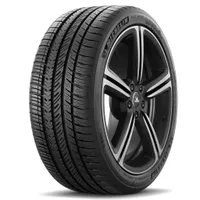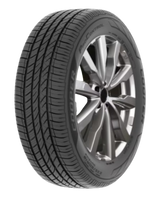Passenger Car/Minivan Tire Size
Passenger cars are the most common type of vehicle that we see on the roads. They offer everything that a day-to-day driver demands, this being reliability, comfort, and efficiency. One key component of such vehicles is their set of tires. The tires are the main connection between the engine and the road, so you should select them carefully.
First of all, passenger cars come in numerous shapes and sizes. Some examples would be sedans, coupes, hatchbacks, convertibles, minivans, and more. So, the tires provide the necessary traction and control, ensuring a cozy and safe journey. Moreover, they are available in a wide range of sizes, tread patterns, and build types to meet as many demands and requirements as possible. It is crucial to select the right set of tires to match your individual needs for the best results.
The Core of Passenger Tires
Starting with the tread, it is the outermost layer of the tire that comes in contact with the road. The tread pattern is carefully designed to offer strong grip and traction, allowing the tire to maintain control in various weather conditions.
Talking about the weather, several conditions require different types of tires that can handle them. For example, summer tires are developed to provide excellent performance in warm temperatures and on dry or wet roads. On the other hand, winter tires feature a more aggressive tread pattern and rubber compound that resists freezing. Its specific design ensures optimal traction and stability on snowy and icy roads. For drivers who want versatility, all season and all weather tires are the go-to options because they spare the hassle of changing tires around the year.
Next, the sidewall is the vertical area between the bead and the tread. Its role is to ensure structural support and protection for the tire by absorbing shocks and impacts. In addition, they protect the rim from curb damage, keeping the aesthetic of your vehicle untouched. Besides, passenger tires feature a belt package located beneath the tread that consists of steel belts wrapped around the tire. These belts upgrade strength and durability, making sure to prevent deformation under pressure.
As for the carcass and bead, they are the foundation of the tire. Several layers of fabric cords and other materials such as polyester or nylon come together to keep everything in place.
The types and technologies of Passenger Tires
Passenger tires are available in tubeless or tube type options. A tubeless tire does not require an inner tube to hold the air pressure. Instead, it forms an airtight seal with the rim, preventing air from leaking. The advantages of such tires include better fuel efficiency thanks to the low rolling resistance, improved handling, and lower risk of deflation.
On the other hand, a tubed tire features an inner tube that holds the air pressure. These are usually cheaper than tubeless ones and don't offer the same advantages. However, they are easier to install on the wheel and the repair process is simple.
Moving on, some tires feature the Run Flat technology that allows drivers to continue driving after a puncture and safely reach an auto shop. For example, Bridgestone's Run Flat tires can handle a maximum speed of 50 mph and a distance of up to 50 miles after a puncture.
Aside from those mentioned above, every brand develops its own technologies to offer the best possible driving experience, so choose your tires carefully.
The most popular Passenger Tires
In addition, passenger tires are classified into Touring, High-Performance, and Ultra-High-Performance, depending on their speed rating.
Touring tires are ideal for drivers who often go on family road trips because they provide superior comfort levels and reliability. However, they don't handle high speeds very well, so drivers choose them mostly for their long tread life, fuel efficiency, and luxury. Some of the best touring tires on the market are Michelin Primacy MXM4, Continental TrueContact Tour, and Cooper CS5 Grand Touring.
High-performance tires are fine-tuned to provide great steering ability and traction at higher speeds. Their heat dispersion is on point, preventing the tire from overheating when speeding on highways. Besides, they usually feature a low sidewall profile to enhance cornering precision. These are ideal for owners of stronger cars who wish to conquer the roads with style. For this category, we recommend the following tires: Hankook Ventus prime2 K115 and Pirelli CINTURATO P7.
And now, ultra-high-performance tires, known as UHP tires, are the strongest of them all in terms of speed capabilities. These tires support speeds of 186 mph and higher, making them suitable for top sports cars such as Ferrari, Bugatti, high-end BMWs, and so on. UHP tires confidently sustain the torque and high horsepower of such vehicles while providing crisp handling and traction. So, if you are looking for the best set of tires to mount on your sports car, then Michelin Pilot Sport 4S and Continental CrossContact UHP are some of the best options on the market.
Finally, choose NeoTires for a broader range of options to suit your needs and requirements. By doing so, will surely find the best deals for your precious vehicle.
Passenger cars are the most common type of vehicle that we see on the roads. They offer everything that a day-to-day driver demands, this being reliability, comfort, and efficiency. One key component of such vehicles is their set of tires. The tires are the main connection between the engine and the road, so you should select them carefully.
First of all, passenger cars come in numerous shapes and sizes. Some examples would be sedans, coupes, hatchbacks, convertibles, minivans, and more. So, the tires provide the necessary traction and control, ensuring a cozy and safe journey. Moreover, they are available in a wide range of sizes, tread patterns, and build types to meet as many demands and requirements as possible. It is crucial to select the right set of tires to match your individual needs for the best results.
The Core of Passenger Tires
Starting with the tread, it is the outermost layer of the tire that comes in contact with the road. The tread pattern is carefully designed to offer strong grip and traction, allowing the tire to maintain control in various weather conditions.
Talking about the weather, several conditions require different types of tires that can handle them. For example, summer tires are developed to provide excellent performance in warm temperatures and on dry or wet roads. On the other hand, winter tires feature a more aggressive tread pattern and rubber compound that resists freezing. Its specific design ensures optimal traction and stability on snowy and icy roads. For drivers who want versatility, all season and all weather tires are the go-to options because they spare the hassle of changing tires around the year.
Next, the sidewall is the vertical area between the bead and the tread. Its role is to ensure structural support and protection for the tire by absorbing shocks and impacts. In addition, they protect the rim from curb damage, keeping the aesthetic of your vehicle untouched. Besides, passenger tires feature a belt package located beneath the tread that consists of steel belts wrapped around the tire. These belts upgrade strength and durability, making sure to prevent deformation under pressure.
As for the carcass and bead, they are the foundation of the tire. Several layers of fabric cords and other materials such as polyester or nylon come together to keep everything in place.
The types and technologies of Passenger Tires
Passenger tires are available in tubeless or tube type options. A tubeless tire does not require an inner tube to hold the air pressure. Instead, it forms an airtight seal with the rim, preventing air from leaking. The advantages of such tires include better fuel efficiency thanks to the low rolling resistance, improved handling, and lower risk of deflation.
On the other hand, a tubed tire features an inner tube that holds the air pressure. These are usually cheaper than tubeless ones and don't offer the same advantages. However, they are easier to install on the wheel and the repair process is simple.
Moving on, some tires feature the Run Flat technology that allows drivers to continue driving after a puncture and safely reach an auto shop. For example, Bridgestone's Run Flat tires can handle a maximum speed of 50 mph and a distance of up to 50 miles after a puncture.
Aside from those mentioned above, every brand develops its own technologies to offer the best possible driving experience, so choose your tires carefully.
The most popular Passenger Tires
In addition, passenger tires are classified into Touring, High-Performance, and Ultra-High-Performance, depending on their speed rating.
Touring tires are ideal for drivers who often go on family road trips because they provide superior comfort levels and reliability. However, they don't handle high speeds very well, so drivers choose them mostly for their long tread life, fuel efficiency, and luxury. Some of the best touring tires on the market are Michelin Primacy MXM4, Continental TrueContact Tour, and Cooper CS5 Grand Touring.
High-performance tires are fine-tuned to provide great steering ability and traction at higher speeds. Their heat dispersion is on point, preventing the tire from overheating when speeding on highways. Besides, they usually feature a low sidewall profile to enhance cornering precision. These are ideal for owners of stronger cars who wish to conquer the roads with style. For this category, we recommend the following tires: Hankook Ventus prime2 K115 and Pirelli CINTURATO P7.
And now, ultra-high-performance tires, known as UHP tires, are the strongest of them all in terms of speed capabilities. These tires support speeds of 186 mph and higher, making them suitable for top sports cars such as Ferrari, Bugatti, high-end BMWs, and so on. UHP tires confidently sustain the torque and high horsepower of such vehicles while providing crisp handling and traction. So, if you are looking for the best set of tires to mount on your sports car, then Michelin Pilot Sport 4S and Continental CrossContact UHP are some of the best options on the market.
Finally, choose NeoTires for a broader range of options to suit your needs and requirements. By doing so, will surely find the best deals for your precious vehicle.
Need live support?
- Mon - Fri: 8am - 7pm ET
- Sat: 9am - 5pm ET
- Sun: Closed







